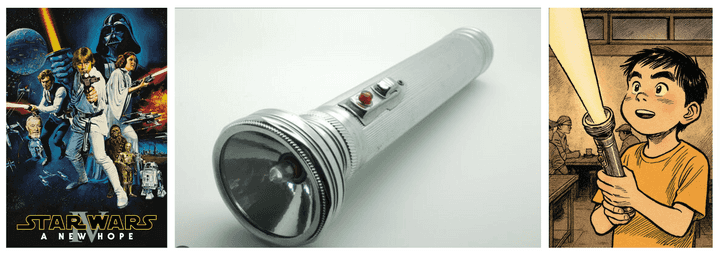Limiting Light: How Would You Build a Lightsaber?
Oct 18, 2025
706 words
~3 min
🇬🇧It was 2003 in a galaxy far far away. I was watching Star Wars for the first time in my uncle’s coffee shop. I had no idea what the story was about — to me it looked like another Power Rangers movie. But one thing immediately caught my attention: Obi-Wan’s lightsaber. It reminded me of something familiar.
I impulsively ran home, grabbed a flashlight, and rushed back. If you lived around that time, you probably remember those standard silver flashlights with the red button. Doesn’t it look like a lightsaber? I turned it on and started playing around, but the light beam kept going and hit the ceiling. I asked my uncle if there was any way to make the light stop shorter. He said, “It’s not possible. We still don’t have the technology to limit the length of light yet.”
It’s been 22 years (or 48 years since the first Star Wars: A New Hope movie). We still can’t make light stop at a fixed point. (Or can we? Maybe someone’s secretly working on it?)
The State of the Art: What Do We Have Now?
From what I’ve found, we already have industrial high-powered lasers that can cut through metal, and plasma cutters used in metalworking that reach temperatures of 20,000°C. A few years ago, Hacksmith Industries build a lightsaber replica using a plasma blade with a laminar flow nozzle to shape it. It looked cool, but with the backpack fuel supply and hose, it still resembled more like a welder than Obi-Wan Kenobi. It’s a progress, but not quite there yet.
So What’s the Challenge?
The fundamental physics problem is that photons have no mass and travel indefinitely until they hit something. They can’t just stop at an arbitrary length in empty air. The saber also needs to be solid enough to clash against another saber, yet light passes through light. It needs to generate extreme heat to cut through materials, but the wielder holds it inches away without protection. And finally, how do you generate enough energy to power all this in something that fits in your hand?
Thought Experiment
What if we stopped trying to make light behave differently and instead gave it something to bounce off of?
Imagine deploying billions of tiny reflective particles from the hilt—particles with some kind of self-mirroring mechanism controlled from the hilt. Maybe electromagnetic fields could hold them in position, similar to how ferrofluids form structures around magnets. Instead of trying to limit the length of light, we’d create a physical structure that light makes visible.
I have no idea if this is feasible. Controlling billions of nanoparticles precisely, keeping them from scattering in air currents, making them rigid enough to clash — it all seems like an enormous challenge. But unlike trying to stop light itself, it doesn’t seem to violate fundamental physics, just our current engineering limits.
Some Other Ideas
I came across a few other approaches that seemed interesting:
Laser-Sustained Plasma Channel: Use a powerful laser to ionize a column of air and continuously sustain plasma in that channel. The challenges here are obvious—enormous power requirements, the plasma would want to rise and dissipate, and it still wouldn’t create a solid blade for blocking.
Photonic Molecules: I read about research from around 2013 showing that photons can be made to interact and form “molecules” in certain quantum states, theoretically creating semi-solid light structures. But this requires temperatures near absolute zero in laboratory conditions. It’s highly experimental and far from practical.
The Implication
Imagine one day, in whatever way, we’re actually able to tackle challenge one: how to limit the length of light.
A lightsaber would be just one small part of the origin story. If we could control energy in fixed shapes without physical barriers, we’d solve problems in medicine like precise surgical tools that don’t damage surrounding tissue, fusion power by containing plasma without massive reactors, and optical computing.
I still have a gut feeling one day we’ll see this happen—maybe when I’m in my fifties. When that day comes, I think I’ll happily run around in my backyard pretending to be a Jedi once again. If you’re thinking about working on this, may the force be with you.
